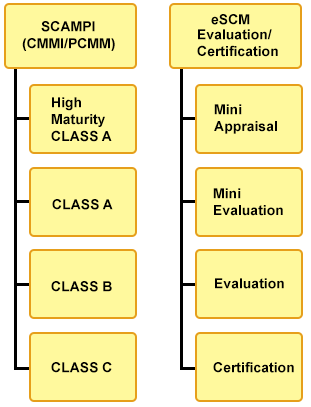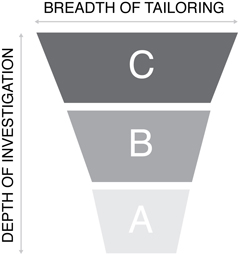
Determining a service provider's or client's capability is at the heart of the eSCM Models, and the ITSqc provides five methods for doing that. They systematically analyze the organization's implementation of the Practices to determine which Practices have been satisfied.
The five Capability Determination methods that are supported by ITSqc are (1) Full Evaluation for Certification, (2) Full Evaluation, (3) Full Self-appraisal, (4) Mini Evaluation, and (5) Mini Self-appraisal.
The five major differences among these methods are (1) their purpose and outcome, (2) who conducts them, (3) who leads them, (4) who sponsors them, and (5) the number of Model Practices that are analyzed (i.e., the model scope). Only a Full Evaluation for Certification can lead to a public Capability Level Certification by the ITSqc.
Appraisal ClassesFor benchmarking against other organizations, appraisals must result in consistent ratings. The SEI has developed a document to assist in identifying or developing appraisal methods that are compatible with the CMMI Product Suite. This document is the Appraisal Requirements for CMMI (ARC).
SEI Appraisal Classes
The ARC describes a full benchmarking class of appraisal as Class A. Other CMMI-based appraisal methods might be more appropriate for a given set of sponsor needs, including self-assessments, initial appraisals, quick-look or mini-appraisals, incremental appraisals, and external appraisals.
Thus, a particular appraisal method is declared an ARC Class A, B, or C appraisal method. This designation implies the sets of ARC requirements that the method developer has addressed when designing the method.
The SCAMPI family of appraisals includes Class A, B, and C appraisal methods.

SCAMPI A is the most rigorous method and the only method that can result in a rating.
SCAMPI BSCAMPI B provides options in model scope, but the characterization of practices is fixed to one scale and is performed on implemented practices.
SCAMPI CSCAMPI C provides a wide range of options, including characterization of planned approaches to process implementation according to a scale defined by the user.
Using SCAMPI B, every practice in the appraisal scope is characterized on a three point scale indicating the risk of CMMI goal satisfaction if the observed practices were deployed across the organizational unit. Model scope is not limited to the Process Areas but could include sets of related practices.
SCAMPI C can be scoped at any level of granularity and the scale can be tailored to the appraisal objectives, which might include the fidelity of observed practices to model/goal achievement or the return on investment to the organization from implementing practices.
Reliability, rigor, and cost might go down from A to B to C, but risk might go up.
| Characteristic | Class A | Class B | Class C |
|---|---|---|---|
| Amount of objective evidence | High | Medium | Low |
| Ratings generated | Yes | No | No |
| Resource needs | High | Medium | Low |
| Team size | Large | Medium | Small |
